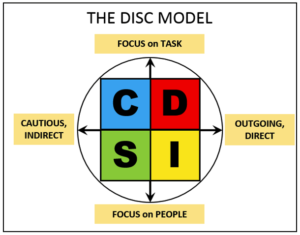Have you ever thought about how you like to communicate and be communicated with?
We usually become aware of these preferences when someone is definitely not interacting the way we prefer!
For example: someone taking ages to explain the details about a deliverable when you just wanted a quick overview, feeling frustrated when someone glosses over important details or talks too quickly or shows little interest in what matters to you.
But before we look at different communication styles let’s pause and consider why it’s worth taking the time to understand them.
To get things done we often need to work with others particularly where a task is large or complicated. Communication underpins how successfully we can engage and work with those around us.
Understanding different styles can help you communicate more effectively with your team and business contacts. Importantly by recognising and adapting to different styles, you can improve your ability to convey your message and avoid misunderstandings.
Have you considered how Is important effective communication is to you?
I would argue that it’s one of the most vital skills that you can develop. It is often the foundation of success for many activities that matter – working well with your team or clients, building great relationships, avoiding or diffusing conflict, achieving important deadlines, developing new products and services.
The list is long!
Why else pay attention to different comms styles?
Cultural awareness:
Communication styles can vary significantly across cultures. By understanding different styles, it’s easier to develop greater cultural awareness and avoid cultural misunderstandings.
Business or career success:
Effective communication is a key skill in many trades and professions. Developing an understanding of different communication styles, can substantially improve your ability to communicate with your team, clients, and business partners, and contribute to your business success.
To sum up, paying attention to different communication styles is essential if you want to communicate effectively, build strong relationships, resolve conflicts more easily, and be culturally aware, all of which will contribute to running a successful business.
Leadership communication
As the leader of our team or project we often want to communicate effectively in order for someone or a group to carry out a task, piece of work or project in accordance with our wishes.
But how many of us consciously and consistently spend time adapting our communication style for different people and different audiences? Even if we do are we using an effective approach to do so?
So, given that effective communication is important the obvious question is what does it look and sound like, what makes communication something someone is prepared, or even wants, to listen to rather than zone out?
And that as they used to say is the $64,000 question.
Especially because, depending on circumstances, each of us will be looking for different things to suit different situations. Think of the difference between a medical emergency versus a first day at work, a close friendship versus a new business contact. The situation is one aspect but underpinning that will be the person’s personal preferences – how do they typically prefer to receive and give information and ideas?
There are different ways in which people express themselves verbally and nonverbally. Here are some common ones:
 Direct communication style:
Direct communication style:
This style is characterised by being clear and straightforward in expressing one’s thoughts and feelings. People who use this style tend to be concise and to the point.
 Indirect communication style:
Indirect communication style:
This style involves using subtle cues, hints, and nonverbal communication to express oneself. People who use this style may be more hesitant to express their thoughts and feelings directly.
 Assertive communication style:
Assertive communication style:
This style involves expressing oneself clearly and confidently, while still respecting the needs and opinions of others. People who use this style tend to be firm and positive without being aggressive.
 Aggressive communication style:
Aggressive communication style:
This style involves expressing oneself in a forceful and confrontational manner, often at the expense of others. People who use this style tend to prioritise their own needs and desires over those of others.
 Passive communication style:
Passive communication style:
This style involves avoiding conflict and expressing oneself in a submissive or apologetic manner. People who use this style may have difficulty asserting themselves or standing up for their own needs.
 Emotive communication style:
Emotive communication style:
This style involves expressing oneself in a way that emphasises emotions and feelings. People who use this style may be more inclined to share personal details and experiences to connect with others.
 Analytical communication style:
Analytical communication style:
This style involves expressing oneself in a logical and factual manner, often using data and evidence to support one’s arguments. People who use this style tend to prioritise accuracy and precision in their communication.
It’s important to note that people may use different communication styles in different situations, and that no one style is inherently better or worse than the others.
Paying more attention to these different styles can help you to communicate more effectively with others and to adjust your own communication style to fit the needs of the situation, particularly in situations where there may be cultural or personality differences.
How to improve your communication skills
Having looked at different types of communication styles and why we might want to understand them, the question now is how. There are several ways that can help you as a person and as a leader lift your understanding.
- Education: Learning about different communication styles through books, articles, or workshops can help with developing an understanding of the various ways people communicate.
- Observation: Paying attention to how people communicate in different situations and contexts can help identify the different communication styles and understand their nuances.
- Active listening: Practicing active listening can help with understanding the communication style of others by focusing on the content of their message, as well as their tone of voice, body language, and other nonverbal cues.
- Cultural awareness: Recognising and respecting cultural differences in communication styles can help avoid misunderstandings and improve the ability to communicate effectively with people from different cultural backgrounds.
- Feedback: Seeking feedback from others about one’s own communication style can help individuals identify their strengths and weaknesses and adjust their approach accordingly.
- Empathy: Developing empathy can help with understanding others’ perspectives and tailoring communication to better suit their needs.
What I have found is that, while experience is a great teacher, it’s useful to use a simple model to short cut the process. The DISC behavioural model in my view is a quick and easy way to gain a rudimentary understanding of a person’s behavioural preferences and hence be able to more readily adapt to their communication likes and dislikes.
 Why I use DISC when I begin working with new clients
Why I use DISC when I begin working with new clients
I find DISC straightforward because it can be used at a very basic level through observing just two dimensions – firstly whether someone is fast or slow in how they go about things, and secondly whether they show more focus on the task or people aspects of a topic or situation.
This allows you to identify what is likely to be their dominant style and tailor your communication accordingly.
The four main styles and the communication focus that going to be the most successful for each are summarised below:
Dominant style:
People with a dominant style are confident, assertive, and direct in their communication. They value results and efficiency and may come across as decisive or even confrontational at times. When communicating with a ‘D’ be direct and get to the point, stick to business and focus on results, and don’t waste time on the small stuff.
Influential style:
Those with an influential style are outgoing and enthusiastic communicators. They enjoy interacting with others and may be seen as charming or persuasive. They often prioritise building relationships and may prioritise socialising over work. When communicating with an ‘I’ build rapport before discussing business, provide a warm and friendly environment, and don’t discuss too much detail.
Steady style:
People with a steady style are calm and patient communicators who prioritise maintaining harmony and stability in their relationships. They value sincerity and consistency and may be seen as empathetic or nurturing. When communicating with an ‘S’ show sincere personal interest in them, be calm, easy-going, and patient, and ask ‘how’ questions to get their opinions.
Conscientious style:
Those with a conscientious style are detail-oriented and analytical communicators who prioritise accuracy and precision. They value logic and reason and may be seen as reserved or even critical at times. When communicating with a ‘C’ don’t be informal, casual, or loud, be organised and prepared, and don’t try and force a quick decision.
It’s worth noting that the DISC model focuses on observable behaviour rather than underlying motivations or personality traits.
As such, these styles are not meant to be a definitive description of someone’s personality, but rather a tool for understanding how they prefer to communicate and be communicated with in different situations.
 As a business owner and leader observing behaviours and communication styles, so that you can tailor your own style and approach to suit a situation you’re dealing with, will ensure the best outcome for all involved. It will allow you to navigate individual preferences and manage potential sources of conflict. Helping your team as well as yourself understand their own and others’ communication preferences will contribute significantly to your ability to build stronger teams and achieve the business outcomes you’re looking for.
As a business owner and leader observing behaviours and communication styles, so that you can tailor your own style and approach to suit a situation you’re dealing with, will ensure the best outcome for all involved. It will allow you to navigate individual preferences and manage potential sources of conflict. Helping your team as well as yourself understand their own and others’ communication preferences will contribute significantly to your ability to build stronger teams and achieve the business outcomes you’re looking for.
I’d love to know if this was helpful.
Here is where to find more information: https://transformationjourney.com.au/services/
Here’s how to connect with me if you’d like information specific to your business:
https://transformationjourney.com.au/contact/ or email: [email protected]

